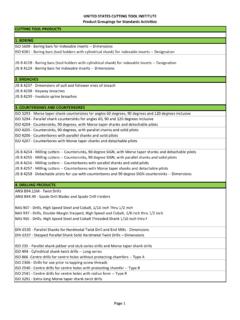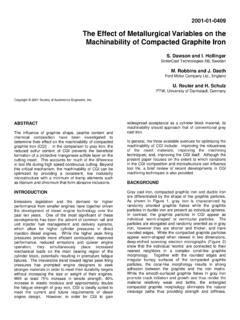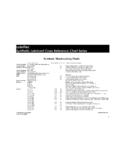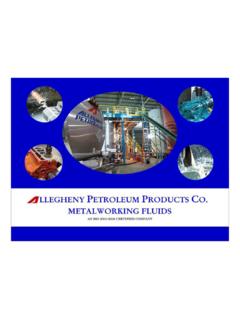Transcription of Dr. Neil Canter / Contributing Editor The …
1 Etalworking fluids are known to provide many benefits to ensure that metal parts can be machined in a cost-effective manner. The positive fea-tures of metalworking fluids have long been established and include friction re-duction, cooling, corrosion protection, welding protection from the tool to the workpiece and the washing away of met-al chips. But metalworking fluids have under-gone intense regulatory scrutiny during the last 20 years. The United Auto Work-ers petitioned the Occupational Safety and Health Administration (OSHA) to lower the permissible exposure limit for metalworking fluids from mg/m3 to mg/m3. In response, OSHA estab-lished the metalworking fluid Standards Advisory Committee (MWFSAC) in 1997 to develop standards or guidelines related to metalworking fluids.
2 In its final report in 1999, MWFSAC recom-mended that the exposure limit be mg/m3 and that medical surveillance, ex-posure monitoring, system management, workplace monitoring and employee training are necessary to monitor worker exposure to metalworking fluids. In the current, competitive manufac-turing environment, end-users of met-alworking fluids are looking to reduce Dry and near-dry machining won t replace traditional metalworking fluid technology anytime soon, but they do offer advantages for some niche Neil Canter / Contributing EditorMThe Possibilities and Limitations of DRY MACHINING 40 MARCH 2009 TRIBOLOGY & LUBRICATION TECHNOLOGY fluids have undergone intense regulatory scrutiny during the last 20 | Special Sectioncosts and improve productivity.
3 The costs of maintain-ing and eventually disposing of metalworking fluids, combined with the aforementioned health and safety concerns, have led to a heightened interest in either eliminating metalworking fluid altogether or limiting the amount of metalworking fluid applied. The former process is known as dry machining while the latter is referred to as near-dry machining or minimum quan-tity lubrication. Different segments of the metalworking communi-ty have estimated metalworking fluid costs in several fashions. Data from tool coatings manufacturer Balz-ers Inc., headquartered in Amherst, , estimates the cost of metalworking fluids to be 16% of the total cost incurred by a typical end-user, as shown in Figure 1. In contrast, STLE-member Doug Hunsicker, a retired se-nior engineering specialist for Caterpillar in Peoria, Ill.
4 , estimates that metalworking fluids represented of his company s total manufacturing costs in 2001. Due to the importance of using metalworking flu-ids, elimination of these lubricants has become quite challenging. A tremendous amount of heat and friction is generated as a cutting tool drives into a workpiece. STLE-member Dr. Emmanuel Ezugwu with The School of Engineering Systems & Design at London s South Bank University, reports that 70% of the heat generated in machining originates with plastic deformation of the workpiece. The remaining 30% of the heat arises from friction at the chip/tool and tool/workpiece Without metalworking fluid , excessive tool wear and inferior surface finish may occur during machining. Both of these factors significantly increase manufactur-ing costs and reduce productivity.
5 THE DRy-MACHINING CHALLENGEM etalworking is composed of a number of different machining operations that place different requirements on the lubricant. Other parameters that must be con-sidered are the alloy of metal being machined, the ma-chine tool and the cutting tool used in the process. Some machining operations are more amenable to dry machining than others, says John Sutherland of Michigan Technological University in Houghton, Mich. Open-faced operations such as milling and boring can be effectively run dry. The resulting chips can be eas-ily moved away from the tool/workpiece interface. In these cases, there is not as great a need for lubricity, and the heat generated can be managed. In contrast, closed-face machining operations such as drilling and tapping cannot be efficiently run dry because the metal chip remains in close proximity to the tool/workpiece interface.
6 This possibility increases the prospects of chips damaging the tool and the work-piece surface because there is no mechanism in place for their reported on early dry-machine studies involving the drilling and boring of cast aluminum al-loys in In those studies, dry machining proved lacking because feed rates needed to be decreased in order to avoid compromising surface finish require-ments. CUTTING TOOL COATINGSA dvances in the types of coatings applied to cutting tools have been the major factor in improving the feasibility of dry machining. Just four years ago, the leading tool coating was aluminum oxide. But coat-ings based on titanium nitride (TiN), titanium carbon-nitride (TiCN) and titanium aluminum nitride (TiAlN) have been developed to withstand more severe operat-ing conditions.
7 TRIBOLOGY & LUBRICATION TECHNOLOGY MARCH 2009 41 KEy CONCEpTS: Dry machining and near-dry machining are two processes MWF end-users are using to reduce costs and improve productivity. Several machining operations are comprised of metalworking and have different requirements on the lubricant. One of the perceived difficulties of near-dry machining is chip 1 | Typical End-User Manufacturing Costs(Source: Balzers, Inc.)In particular, TiAlN has emerged because this coat-ing exhibits thermal stability up to a temperature of 900 C. Coatings increase tooling costs by an average of only 10%. Torsten Doering, Balzers market manager, indicated that his company has combined TiAlN with tungsten carbide carbon to generate even better tooling performance. This coating displays a very low friction coefficient, enabling its use in deep hole drilling under almost dry conditions, he Quinto, technical director for Balzers, indi-cated that mold steels such as 4140 and 4340 can be milled and shaped with coated tooling.
8 These alloys typically have Rockwell hardness ratings (HRC) rang-ing from 52 to 58 HRC. But there are limitations be-cause metals such as titanium and stainless steel are not amenable to dry machining. The former metal exhibits a very low thermal conductivity rating, which means that heat cannot be effectively carried away from the tool/workpiece interface. Stainless steel machining typically produces long chips that extend the contact length between the chip and the tool and, as a con-sequence, increases the amount of heat in the cutting zone. Milling is a popular operation to run dry, particu-larly because tool life can be superior under dry as op-posed to wet conditions, according to Quinto. Cool-ant use in milling leads to higher fluctuations in the temperature of the cutting edge as the tool goes in and out of the cut, he says.
9 This effect can cause ther-mal cracking, leading to premature tool failure by edge microfracture. Under dry conditions, the temperature does not change that dramatically, which extends the life of the tool. Ezugwu indicated that coated cutting tools can be used without metalworking fluid in hard turning. This finishing process is used on steels with hardness rat-ings above 60 HRC at cutting speeds two to four times higher than those used for conventional cutting tools. DRy MACHINING LIMITATIONSW hile the technology to carry out dry machining has improved, metalworking fluid is needed to ensure that higher speeds and feeds can be used and to ensure that the surface finish of workpieces meets expectations. Hunsicker revealed that Caterpillar has tried dry ma-chining in a number of machining operations during the past 20 years.
10 The new tool coatings have been helpful but still the problem exists that ma-chining cannot be done dry at the rate needed to achieve the productivity found with using metalworking fluids. STLE-member John Cutcher, technical director for Stu-art Co. in Warrenville, Ill., has not seen any increase in dry machining beyond its use on cast iron. He believes that dry machining cannot overcome the positive benefits of using metal-working fluids. One other fac-tor to consider is the production of particulate. Cutcher claims that dry machining can produce as much air particulate as wet machining. Data supporting Cutcher has been published by Woskie 42 MARCH 2009 TRIBOLOGY & LUBRICATION TECHNOLOGY in the types of coatings applied to cutting tools have been the major factor in improving the feasibility of dry 2 | A cylinder head being processed with HORKOS near-dry technology (Courtesy of Horkos Corp.)




